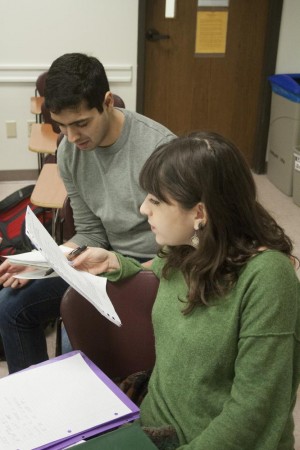Scene
Major in South Asian studies on the horizon
Professor Mohammad Warsi observes Beginning Hindi students as they practice Hindi speech on Wednesday afternoon. Due to popular demand, three sections of the course were opened in Fall 2013.
Warsi, a senior lecturer in South Asian languages, believes the major could become a reality with the introduction of a few more courses, particularly in South Asian literature, and with the hiring of a couple faculty members.
While neither Warsi nor JINELC department chair Hillel Kieval could put a timetable on when the major would be available for students, both are hopeful that it will be open in the near future, maybe as soon as 2015.
Demand for more academic emphasis on South Asia has become evident over the past year. After registration for Fall 2013, the Beginning Hindi class had 15 seats but 18 enrolled students and 26 more students on the waitlist. The department had to open two additional sections to accommodate the interested students. According to Warsi, retention from Hindi 111 in the fall to Hindi 112 in the spring was also very high this year.
“There is pretty good student demand for increased visibility for South Asian languages, culture, history, maybe also anthropology, on the Wash. U. campus. As to what form that might ultimately take, I don’t know, but I do think the University ought to encourage this student demand and develop South Asian studies a little bit further,” Kieval said.
Warsi was born and educated in India before moving to the University of Michigan and the University of California-Berkeley to teach. He has a background in linguistics and has led the movement for more South Asian involvement at Wash. U.
“Relatively, [Michigan and Berkeley] have bigger South Asian programs. Having influence from those two programs, it was a small department here. Since I came here, we have slowly started building the program,” Warsi said.
Following growth across multiple departments, the College of Arts & Sciences introduced a minor in South Asian languages and culture in 2009. Students are required to take 18 credits for the minor but can choose from courses varying from Hindi language classes at three different levels to Introduction to Indian Music in the Music department.
Warsi indicated that he would like to see more South Asian languages taught in the future, including Urdu and Gujarati.
Seniors Lily Pinchoff and Rahul Jaswaney go over a reading exercise in Beginning Hindi. The course meets each day of the week to provide an immersive experience.
The proposed major is just one part of a greater push to build on the University’s relationship with South Asia. Wash. U. recently opened a recruitment center in India to attract strong international students from the area.
In May 2013, a group of 53 faculty and staff met in Holmes Lounge to discuss what was called the “India Initiative,” a task force looking to connect Wash. U. with universities and researchers in India.
Cassie Adcock, an assistant professor of South Asian studies in the History department, said that, while the initiative is in its early stages, she has high hopes for what it can accomplish.
“India Initiative” is “just to start a conversation about how to expand our connections with South Asia in various kinds of ways. That means both recruitment of students over there and also expanding the presence of South Asia on campus in different kinds of ways,” Adcock said.
Several students indicated that had a major in South Asian studies existed when they were underclassmen, they would have strongly considered it.
“I’m taking my sixth semester of Hindi, and I’m sad that there aren’t more courses offered. I would have 110 percent pursued a South Asian studies major if it was offered,” junior Sandya Muchimilli said.
“I think [a major] is definitely something I would have considered since I took Hindi for so long. I’m still interested in South Asian history, so I think if it was an option, I definitely would have considered it,” senior Hina Malik, who was a teaching assistant in Beginning Hindi in Fall 2013, said.
Kieval encouraged students interested in pursuing South Asian studies not to allow the lack of a major to stop them. He cited a combination of a major in Islamic studies with a minor in South Asian language and culture that would cover a majority of relevant courses.
“A student who wishes to devote his or her undergraduate years to really intensely study South Asian languages, culture, history and literature can still do so…there are ways of putting together a really robust kind of program for students without waiting for the creation of some formal South Asian major,” Kieval said.


